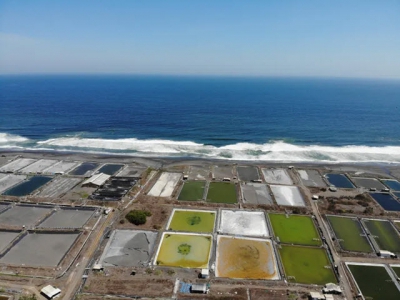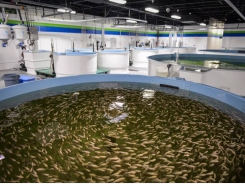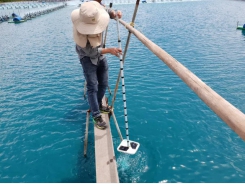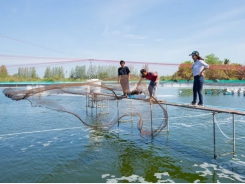Everything you need to know about EMS in shrimp farming - Part 2

Losses caused by EMS/AHPND
EMS/AHPND has been wreaking havoc in Asian shrimp aquaculture over the last 10 years. As seen in Figure 1, one of the most affected countries in the region is Thailand, which was second largest shrimp producer in the world after China pre-AHPND and has now fallen to the sixth spot.
Since the outbreak of EMS/AHPND in 2012, Thai shrimp production has experienced a significant loss. Total production fell by 54 percent between 2009 and 2014. The number of farms also decreased by 16 percent, while the land area used for shrimp production fell by 10 percent. Another report stated that between 2010–2016, the disease caused financial losses of $11.58 billion in Thailand and more than 100,000 job losses.

Figure 1. Production of L. vannamei and its subsequent losses due to AHPND. Photo: Shinn, et al., 2018
Other affected countries have not suffered as much as Thailand, but losses are still significant. In Vietnam, for instance, AHPND has caused a $2.56 billion loss since its first emergence in 2011. Many shrimp producing countries affected by AHPND are still recovering from the outbreak and many other unaffected countries are preparing prevention measures to stop its spread.
Learning from Thailand
As a shrimp-producing country that suffered the biggest blow, Thailand is still recovering from the EMS/AHPND outbreak. Farmers in Thailand have started to shift their farming practices to counteract Vibrio spp. bacteria infection and prevent another outbreak.
A new intensive farm design has been developed, which aims to maintain a clean pond bottom. The new design is based on recirculation and flow-through systems, with four important components:
- Increased water treatment areas
- Smaller grow-out pond size
- Central drain/shrimp toilet
- Increased aeration

Figure 2. Comparison of farm layout before and after EMS/AHPND in Thailand. Photo: Kawahigashi, 2018
The ratio of reservoirs to grow-out ponds has been drastically changed – from 20%:80% to 60%:40%. The increased volume of reservoirs provides more water storage and makes more water exchange possible – helping to minimise disease risks and manage water quality. Supported with tilapia and/or milkfish polyculture, the water from pre-treatment areas is transferred to the tilapia or milkfish ponds, which are stocked with fish at a density of 1–2 kg/m2. Both organisms can help maintain good water quality and improve sediment quality by grazing organic wastes in the water.
The water is then transferred to the grow-out pond, which is equipped with HDPE plastic liners used to avoid pond bottom erosion due to high aeration. The grow-out pond size is reduced to optimise the oxygenation process whilst efficiently utilising water movement to push the sediment towards the shrimp toilet. The reduced surface area – from the average of 8,000m2 to 1,500m2, or even as small as 500m2 – is compensated for by a water column up to 3 metres deep, in order to provide a greater stocking density.
Meanwhile the shrimp toilets are utilised to collect sediment in one place so that it can be removed easily. The recommended surface area for the shrimp toilet is 5–7 percent of the total pond area and pond bottoms should have a slope of 25–30 degrees and be lined with plastic to make the sediment fall inside more easily. Non-stop aeration is needed to make sure that the sediment is pushed to the toilet. The energy budget for aeration may vary, depending on pond depth and area, but the usual is around 70 to 100 horse power (hp) of energy per hectare.
When the cycle is finished, the water will be transferred back to the pre-treatment area. This is done to reduce the intake of water which may have high pathogen load. As a result, it reduces the risk of pathogen spread from outside sources, as well as the volume of effluent output. It also increases the farm's sustainability.
As seen in Figure 3, Thailand’s shrimp production is growing. These new systems require investment in infrastructure and improved management teams. This transition takes time and requires significant national consensus and fiscal support, which has led to the dramatic consolidation of the industry. It should be noted that Thailand has other conditions, such as tax and national industry structuring, which have further limited the sector’s expansion post-EMS.

Figure 3: Thailand’s shrimp production market, 2012–2022E. Photo: BCG, 2019
Related news
Tools

Phối trộn thức ăn chăn nuôi

Pha dung dịch thủy canh

Định mức cho tôm ăn

Phối trộn phân bón NPK

Xác định tỷ lệ tôm sống

Chuyển đổi đơn vị phân bón

Xác định công suất sục khí

Chuyển đổi đơn vị tôm

Tính diện tích nhà kính

Tính thể tích ao




 Everything you need to know about EMS in…
Everything you need to know about EMS in…  Top 10 tips for shrimp farming – the…
Top 10 tips for shrimp farming – the…